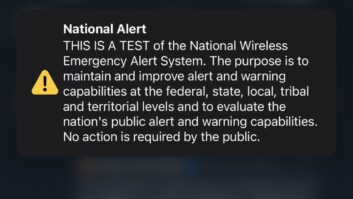The listing for the third webinar has been updated to show that June 7 is a Tuesday.
The date of the next regional IPAWS EAS test has been pushed back.
The test involves western and northern states: California, Colorado, Idaho, Montana, Oregon, North Dakota, South Dakota, Washington, and Wyoming. It has been moved to Wednesday, June 15at 1:20 p.m. Pacific and 2:20 p.m. Mountain.
It had been set for the week prior, but emergency planners will be conducting Cascadia Rising, a separate exercise to explore response to a major earthquake along the Cascadia Subduction Zone.
So the next regional IPAWS EAS test is now set for the following week. Its impetus remains the same. Broadcast and cable operators serving these states are being asked by the Federal Emergency Management Agency to participate in this voluntary test by configuring their EAS devices to forward an EAS message containing a National Periodic Test (NPT) event code.
The agency also added an additional webinar to its technical webinar lineup, and adjusted a few dates and times accordingly. Each webinar will begin with a brief explanation of IPAWS and how it works in relation to EAS, followed by EAS device configuration instructions for those interested in participating in the test, said Al Kenyon, IPAWS national test technical lead.
According to FEMA, the same material will be presented in all three webinars.
For all three webinars, the call in number is 800-320-4330 and the access code is 506 311.
June Test Technical Webinar I
Thursday, May 26, 2016
10 a.m. Pacific/ 11 a.m. Mountain
Event address for attendees: https://fema.connectsolutions.com/ipaws-eas-test/
June Test Technical Webinar II
Thursday, June 2, 2016
1 p.m. Pacific/ 2 p.m. Mountain
Event address for attendees: https://fema.connectsolutions.com/ipaws-eas-test2/
June Test Technical Webinar III
Tuesday, June 7, 2016
12 p.m. Pacific/ 1 p.m. Mountain
Event address for attendees: https://fema.connectsolutions.com/ipaws-eas-test3/
An earlier webinar was aimed at non-technical managers. For those who missed it, the first few minutes of the technical webinars will cover basics from a non-technical perspective to help get those listeners up to speed, Kenyon said.










